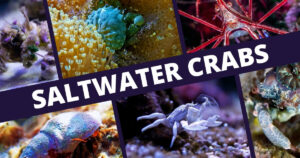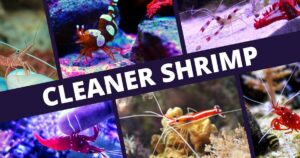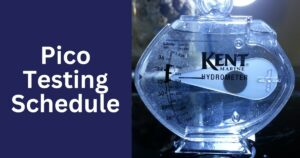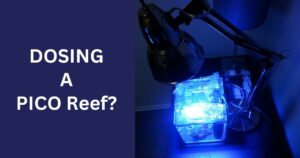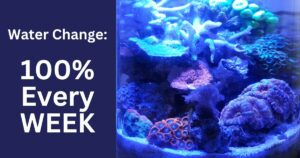Circulation is so important for corals and other aquatic life.
- It helps brings nutrients and food to them.
- Moves waste away from them.
- Helps with the transfer of important gases like oxygen and carbon dioxide between water and air
- Helps stabilize water conditions throughout your reef.
In this article we are going to discuss options for circulation in our pico reef tanks. Keep in mind that you will still need to research about each of your corals needs and preferences.
Circulation Is Important!
Many corals slime up when stressed, or shed when growing, without proper circulation they would either suffocate, or die from a lack of food or light when algae grows over top of these waste layers.
Some corals need a strong flow to remain healthy and promote growth, while others need a very gentle flow across their delicate tissues. So beyond just having circulation, it’s also important to know what your current and future corals will require.
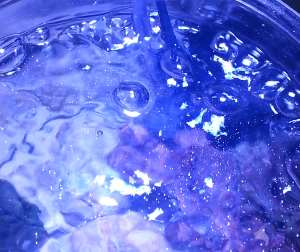
Surface agitation helps with gas exchange and so does circulation of water from the bottom to the top of your reef. The amounts of carbon dioxide and oxygen in the water can affect things such as pH, which often changes when the lights are off during the night and again when they come back on.
pH is affected by many things, including temperature, and usually drops during dark photo periods because oxygen levels drop. Why? No coral photosynthesis, no oxygen creation.
Circulation and surface agitation can help help with oxygen saturation levels to help keep pH stable. Some methods are better than others.
Okay, circulation is important. Let’s look at how we move water in a pico reef.
Internal Pumps & Power Heads
Many people look towards power heads or internal pumps because they are usually quiet. If your pico reef is located on your work desk, having the sounds of running water or bubbles may not be ideal.
However, there are many disadvantages to them with it comes to pico reefing. Some of them are deal breakers!
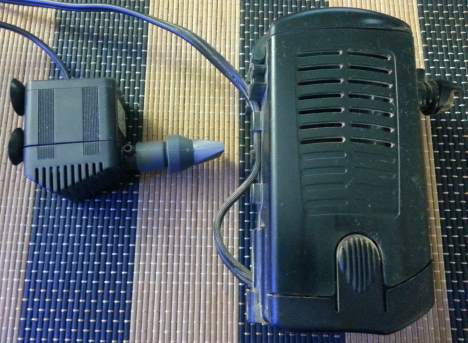
Pros
- Quiet operation
- May be easy to hide
Cons
- Heat – My #1 issue!
- Like a blender – May kill small critters!
- If using a sponge filter, it can be a trap for detritus to rot
- Too much flow – Can create whirlpool effect
- Flow is single direction – No space for sweepers
- Another electrical cord going in to the reef
- Lack of surface agitation can cause poor gas exchange
- Some models are large, hard to hide
- Bulky – Takes up valuable real estate inside the reef
- Pump maintenance – Disassembly & Cleaning
Heat – The Biggest Disadvantage
I’ve tried several different types of small internal pumps (such as the Rio50) and powerheads in 2 gallons of water and the lowest I was able to secure was about 81c during the colder months here in Canada.
Of course there are other factors such as the thickness of glass of my cookie jar, but the creation of heat alone is a deal breaker.
The biggest key for temperature is being consistent, but anything beyond 83f is a death sentence for most corals in my opinion, so it doesn’t leave us with much room for error at 81c.
I currently keep my jar temperature between 79f-80f since I can keep this range consistent even during the summer months.
Another issue is too much flow. Even a small rio50 might turn your pico in to a whirlpool. Currently, there aren’t a lot of options for smaller sized reef tanks.
Safety Of Livestock
And another issue I wanted to point out is the safety of your livestock.
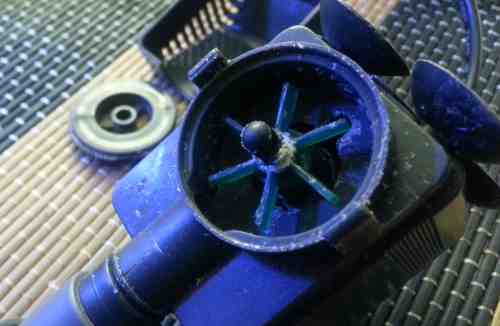
Small creatures like amphipods, copepods, and worms may easily be sucked up through filter grates and ground up in to tiny pieces. This would lead to poor water quality very quickly as the minced critters decay.
If you decided to use a sponge over the intake, this would create a trap for detritus and if not cleaned regularly, will start to pollute the water.
Disassembly & Cleaning
Every so often an internal pump will need to be taken out to be cleaned.
Taking things in and out of a matured pico reef is very difficult because there is not much room to maneuver. You may need to move rocks which have glued themselves together or move corals which aren’t able to be moved without breaking. It’s just a big hassle.
As much as I’d love to have a silent pico reef by using an internal pump, or powerhead, it just isn’t in the cards as of yet.
Air Pumps & Bubbles (Best Choice)
A simple air pump and air line can create bubbles that not only circulate water but help stabilize it. It’s the preferred choice for a small pico reef.
Note: Make sure you buy a “check valve” for your air line (a check valve is a one way valve). It makes certain that air, or liquid, can only travel in one direction.
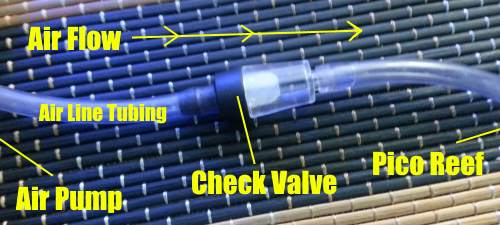
Check valves are cheap insurance!
In the case of a power outage, or other issue, a check valve should stop water from siphoning from your reef all the way to your air pump. If salt water gets to the air pump, it could cause a fire.
You should also make sure that you have a drip loop for both the air line and power cord, just in case water makes its way down any of these. Again, it could cause a fire.
Pros
- Circulates water effectively
- Variable directional flow (simulates ocean currents)
- Can control the flow
- Helps stabilize water pH
- No electrical cords in the water
- Bubbles can create a protein skimmer effect
- Easy to maintain
Cons
- Back siphon
- Noise
- Need to secure the air line with suction cups (they can fail)
Flow
When bubbles rise they create a vacuum behind them. This vacuum draws in water. Therefore, as the bubbles rise they draw water behind them and create flow.
Because bubbles are created slightly different each time and rise a little different from the next, it creates a more varied flow. This change can create random currents in your pico reef. I liken it to currents in the ocean which are most ideal. The best part is that this happens automatically.
Flow Control
We can control the water flow quite easily by:
- reducing the amount of bubbles created (using an air pump with a dial or regulator connector),
- by diffusing the bubbles using a ceramic air stone (not the sandy ones because they will break apart in salt water quickly),
- or by simply using an air line with nothing on the end to create large strong bubbles.
I choose to have no air stone which creates larger bubbles for more flow.
How big of a pump do I need?
This is where it gets a bit tricky. I’m using a Marina 75 for my 2 gallon jar reef (The package says ideal for 10-25 gal. However, that doesn’t mean it’s rated to create complete circulation for a 10-25 gal tank. It might just mean to handle a bubble bar that fits a tank of that size. Who knows?!).
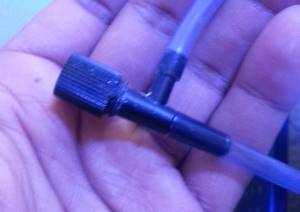
This air regulator needs to be installed BETWEEN YOUR PUMP AND CHECK VALVE. WARNING: If it is installed between your check valve and reef, and there is pump or power failure, it will leak at the air regulator, possibly causing water damage or a fire!
The Marina 75 is a pretty strong pump, so I am using an air regulator connector (as seen above) to control the flow. No matter which pump you choose, you need to have the option to control the flow.
How much flow do I need?
This is a big topic and depends on the types of corals you are keeping. for the purposes of this article, I think it’s best to see other pico reef examples and replicate what they are doing. Make sure that they have an established system.
In general, SPS corals like higher flow whereas LPS do not (in fact high flow can rip the tissues right off them).
In the video of my jar reef, pay particular attention to the small bubbles floating around and the way the corals are moving. Try to find similar examples in other successful reefs.
Bubbles
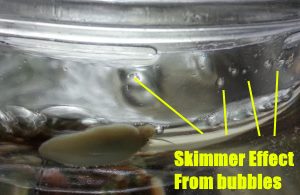
As mentioned at the beginning of this article, surface agitation and circulation is important. Bubbles do this really effectively and continue to do it during the night.
Because bubbles aid in gas exchange, it helps with pH stabilization during the night, therefore reducing the size of the pH swing that all systems go through. Again, we strive to be as consistent as possible with all of our parameters so this is a huge benefit.
Bubbles can also create a protein skimmer effect on the sides of your tank. This is great because the froth and detritus that collects above the waters surface, can be wiped away easily. It might not be a lot, but every bit of filtration helps.
Won’t bubbles kill my corals?
This is one of those debatable topics that has gone on for years. The claim is that bubbles, or mico bubbles, would either collect on or under a coral and cause that section to die (or get infected) and end up killing the entire coral.
Here is why I don’t agree:
- Corals deal with bubbles in the ocean all the time, especially in surf areas.
- Most corals can slime to protect themselves from exposed areas. Like when the tide goes out for hours under hot sun. The slime could also move the bubbles.
- Some corals can move or adjust to avoid uncomfortable situations.
- We have many examples of pico reefs using air bubbles. I haven’t ever heard or seen of an issue caused by bubbles, including my reef jar.
Back Siphon
In the event of a power outage or pump failure, it’s possible for water to start siphoning back through the air line.
As noted above, a check valve can be used to prevent water from getting all the way back to your pump and is highly recommended.
Noise – Pumps & Air Lines
The downside is that bubbles are noisy and some air pumps can be noisy as well.
Air Line Not Airline
You will need to secure your air line using suction cups to the inside of your pico reef tank. If you don’t, the air line will either come out of your tank or curl very badly.
This could lead to blowing sand everywhere, curling so much that the tip is out of the water, or curl under rocks and vibrate them against your tank which could lead to scratches, breaking and leaks.
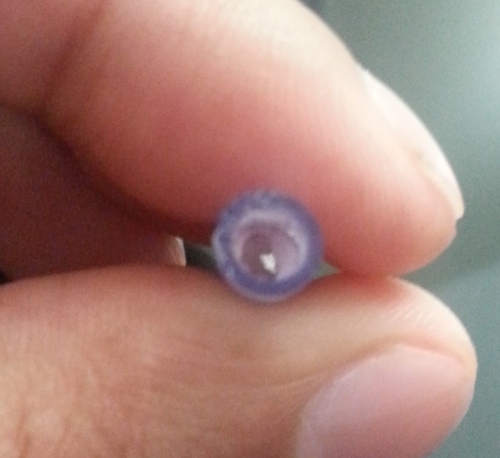
Plugged Air Line – Salt build-up over a couple months
Salt can build up inside the tip causing it to become completely plugged. This excess pressure on the pump can then lead to failure or fire.
The end of the airline will also need to be inspected and cleaned during your weekly maintenance. I remove the airline once a week during maintenance, dip the end in RO water (about 2 inches), use a pipe cleaner to scrub the inside, dip it again in RO water before reinstalling.
Pump
To help prevent noise from your air pump, you can place a piece of thick piece of rubber or sponge under their feet.
Some people place air pumps on kitchen towels or other fabrics, but this can lead to overheating and cause a fire. Always follow the manufacturers instructions.
Air Line Heater Mod
Here is something I devised to keep the airline in the exact same place every time. It consists of a piece of hard air line tubing super glued to the plastic parts of the heater mount. DO NOT GLUE ANYTHING OR TOUCH ANYTHING TO THE HEATER!
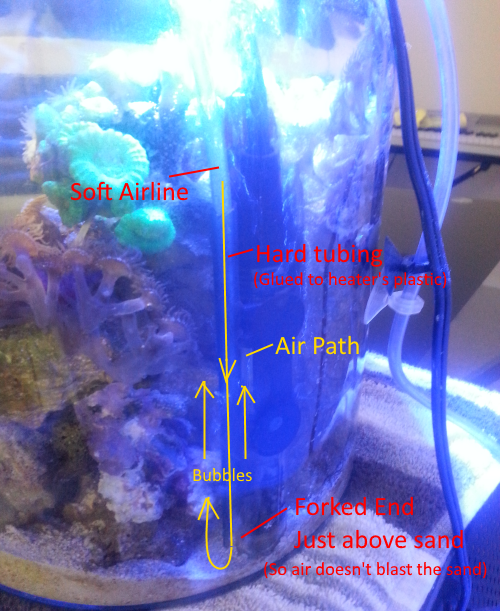
The airline tubing just barely fits in to the hard airline which keeps it snug enough to hold in place. I cut the end of the hard air line in to a “fork” so that there is space for the bubbles to escape without disrupting the sand.
Of course the soft air line is not pushed all the way through the hard air line, it’s stopped about 1cm before the fork.
Final Thoughts
An air pump and air line are the way to go for a small pico reef.
While they have their disadvantages, I think they are much less of an issue than those of an internal pump, especially when it comes to heat and potentially blending critters.
I used to hate the noise from the jar reef on my desk, but I’ve gotten used to it over the months and it doesn’t really phase me that much anymore. In fact, if I didn’t hear it, I’d know there is a problem right away.
Did you enjoy this article? Let me know in the comments below with your experiences, questions or concerns.

